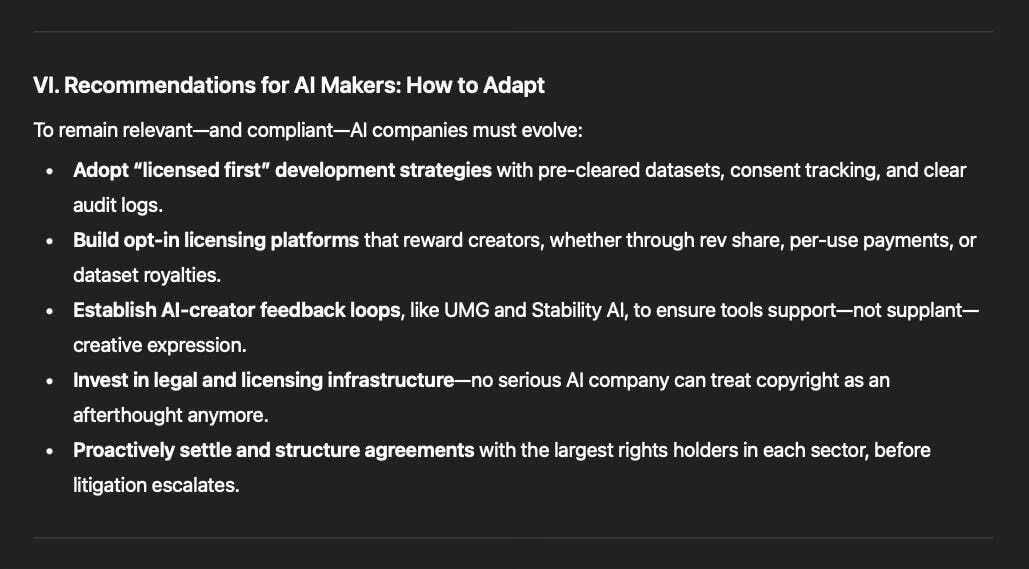- Pascal's Chatbot Q&As
- Posts
- UMG’s actions—first settling litigation with Udio, then allying with Stability AI—are not just tactical business moves. They are signposts of a new AI-content détente...
UMG’s actions—first settling litigation with Udio, then allying with Stability AI—are not just tactical business moves. They are signposts of a new AI-content détente...
...one that could unlock monetization at scale while protecting creator rights. The lesson is simple but urgent: litigate if you must, but license if you can.
Universal Music’s Strategic AI Pivot—Implications for Rights Owners, Litigation, AI Developers, and Regulators
by ChatGPT-4o
Universal Music Group’s (UMG) back-to-back announcements—settling its lawsuit with AI music platform Udio and entering a strategic alliance with Stability AI—mark a watershed moment in the intersection of AI, copyright, and creative industries. These moves, just ahead of a key earnings report, signal a tactical shift from legal confrontation to commercial collaboration, with far-reaching implications for content rights owners, ongoing litigation, AI developers, and global regulators.
I. Implications for Rights Owners Across Sectors
UMG’s actions reflect a broader industry realization: the AI genie is out of the bottle, and rights holders must now negotiate its terms of release. The Udio settlement includes not just compensatory payments but a forward-looking commercial deal for a licensed, walled-garden AI music platform—effectively legitimizing AI-assisted creation under strict usage conditions. Stability AI, meanwhile, has agreed to develop “next-generation music tools” using only licensed datasets, with artists embedded in the co-development process.
This shift represents a potential playbook for rights holders in publishing, film, journalism, and beyond:
Litigation is leverage, but licensing is the endgame.
Embedding rights holders in AI development can ensure influence, mitigate infringement risks, and shape monetization models.
“Walled garden” models—where outputs are controlled, logged, and fingerprinted—may become a preferred compromise, offering both creative freedom and enforceability.
II. Signals for Current Copyright Litigation
UMG’s actions may reverberate across multiple active lawsuits:
Getty Images v. Stability AI (image rights),
The New York Times v. OpenAI (text and journalism),
Universal and Warner v. Suno (ongoing AI music infringement),
and various artist class actions against generative AI platforms.
Rather than pushing for full bans or injunctive relief, plaintiffs may increasingly:
use litigation as a forcing mechanism to bring AI companies to the table,
negotiate upfront licensing fees, back-payments, and rev share models,
demand transparent datasets and training audits as part of settlements.
UMG’s deal with Udio sets a precedent: lawsuits don’t have to end in scorched earth. They can catalyze new commercial models—with licensing, filtering, and usage tracking baked into the AI platform itself.
III. Relevance for AI Developers
AI companies should see this as both a warning and an opportunity. The message is clear:
Training on copyrighted data without consent is no longer a viable grey zone—especially for music, film, and books, where owners have direct evidence and leverage.
Voluntary licensing marketplaces like the one Stability AI is reportedly developing may become a regulatory requirement or competitive advantage.
Working with rights holders isn’t just reputational risk mitigation—it’s a gateway to stable, legally defensible, and monetizable models.
Importantly, the “next-generation” AI tools UMG envisions are meant to enhance artists’ workflows—not replace them. Developers should prioritize co-pilot, assistive, and collaborative tools over disruptive, zero-compensation “replacement” models.
IV. Impact on Regulators
These moves could reshape the policy debate in several ways:
Self-regulation via licensing agreements might reduce (but not eliminate) pressure for AI-specific copyright legislation.
Regulators may look more favorably on AI firms that publicly commit to licensed, traceable, and consent-based training—and less so on those that fight transparency.
The emergence of “safe harbor” AI zones—walled environments with licensed inputs and usage logs—may become a regulatory template.
Moreover, deals like UMG’s give lawmakers a real-world alternative to prohibition: structured innovation under licensing safeguards, supporting both creator incomes and technological advancement.
V. Future Outlook: Where This Could Lead
If this becomes the standard, we can expect:
AI licensing ecosystems to emerge across sectors (e.g., literary, academic, cinematic, gaming).
Litigation-to-licensing pipelines to formalize as a strategic norm.
AI transparency metrics (dataset provenance, model lineage, output tracking) to be demanded by both partners and regulators.
A new industry role: AI Rights Integrators—trusted third parties managing rights, licensing metadata, and audit trails between content owners and AI firms.
A bifurcation of the AI market: one path toward licensed, enterprise-grade tools, and another path of open, unlicensed “wild” models increasingly pushed to the margins.
VI. Recommendations for AI Makers: How to Adapt
To remain relevant—and compliant—AI companies must evolve:
Adopt “licensed first” development strategies with pre-cleared datasets, consent tracking, and clear audit logs.
Build opt-in licensing platforms that reward creators, whether through rev share, per-use payments, or dataset royalties.
Establish AI-creator feedback loops, like UMG and Stability AI, to ensure tools support—not supplant—creative expression.
Invest in legal and licensing infrastructure—no serious AI company can treat copyright as an afterthought anymore.
Proactively settle and structure agreements with the largest rights holders in each sector, before litigation escalates.
Conclusion
UMG’s actions—first settling litigation with Udio, then allying with Stability AI—are not just tactical business moves. They are signposts of a new AI-content détente: one that could unlock monetization at scale while protecting creator rights. For publishers, studios, and AI makers alike, the lesson is simple but urgent: litigate if you must, but license if you can. The next generation of AI isn’t built on theft—it’s built on trust, transparency, and shared value.
